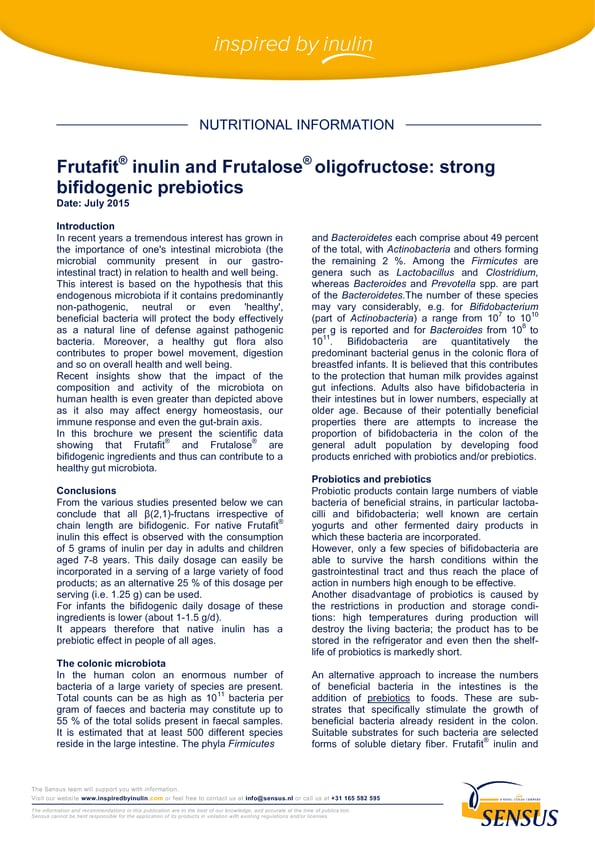In recent years, there has been tremendous interest in the importance of the intestinal microbiota, the microorganisms present in our gastrointestinal (GI) tract, in relation to health and wellbeing.
Research has shown that the gut microbiome is of extreme importance for human health and that the human body benefits from the interaction with the microbiota. What is the microbiome, how can you positively influence it with diet and what might the future bring with regards to the microbiome?
The microbiota refers to the microorganisms that live inside and on humans and includes bacteria, archaea, fungi and viruses. They can be found on the skin, in the digestive tract, the vagina, urinary tract and the oral cavity. These microbiota, the environment where they are active and the whole spectrum of molecules produced by the microorganisms are together called the microbiome.1 The environment defines the microbiome, therefore we have, for example, a skin microbiome, a gut microbiome, and an oral microbiome. The microbiome contributes to a person’s biology and it protects against pathogens.2,3
The gut microbiome is the part of the human body where the greatest density and number of microbiota are found. Studies have shown that the microbiome of healthy individuals is as unique as a fingerprint. However, some of the microbial communities in the GI tract are comparable between individuals, for example because people are genetically related, similar in age or have common diets. The microbiota in the GI tract play an important role in digestion, the production of essential vitamins, and protection against pathogens.4
Role of prebiotics in the microbiome
The microbiota in our gut ferment non-digestible carbohydrates, like prebiotic fibers. The International Scientific Association for Probiotics and Prebiotics (ISAPP) defines a prebiotic as ‘a substrate that is selectively utilized by host microorganisms conferring a health benefit’.5 This means that a prebiotic should only be fermented by one or a few friendly microbes present in the intestine and it must show a scientifically proven health benefit. ISAPP has officially recognized inulin, fructooligosaccharides (FOS), and galactooligosaccharides (GOS) as prebiotics.
Prebiotics reach the human colon intact where they are selectively fermented by friendly microbiota, like bifidobacteria or lactobacilli. These microbiota ferment the prebiotics to short-chain fatty acids (SCFAs) and gases while increasing in number. In particular these SCFAs are associated with several health benefits as they are absorbed and used as an energy source by the whole body. For example, the colon cells will use them and as a result they will function better and support a regular digestion with softer stools, besides improving our protection against chemicals and pathogens.6
Moreover, there is increasing evidence that a healthy gut microbiome with production of lots of SCFAs is associated with an improved immunity and less inflammation.7 In contrast, an imbalance between good and bad bacteria in the GI tract, called dysbiosis, is implicated in developing issues such as Irritable Bowel Syndrome (IBS) and impaired metabolism such as diabetes.3 Therefore, it is important to take good care of the microbiota in the gut, for example by eating products that contain prebiotics like inulin, FOS or GOS.
Gut-brain axis
One of the newer health areas to receive increasing attention in relation to prebiotics and the microbiome is the gut-brain axis. In fact, the nervous system present in our gut, also called the enteric nervous system, is the second largest nervous network after that of our brain and has also been referred to as the ‘second brain’.8 The contents of our gut, such as food and microbiota, constantly interact with this ‘second brain’ providing signals to the brain about information, such as hunger and feelings of stress and fear.
Recently, human studies are beginning to emerge showing that prebiotics might affect mental health. Bifidobacteria and lactobacilli ferment prebiotics and bifidobacteria then remarkably increase in number. In one study, subjects ingested a snack bar with 8g inulin-type fructans (ITF) twice a day for 12 weeks. The Mental Health score showed a significant improvement in the ITF group, which was not noted in the placebo group.9 In addition, an acute study found that, after ingestion of 5g ITF, mood and episodic memory improved compared with a placebo.10
A link between the community of bacteria living in our gut and the brain has been established. Therefore, dietary changes, such as increasing the intake of fibers and prebiotics that can influence gut microbiota composition and increase SCFAs, are a viable approach to influence mental health.
Personalized nutrition
Another interesting opportunity arising around the gut microbiome is personalized nutrition. Research is increasingly focused on the microbiome and its interplay with nutrition, diets and disease. Furthermore, there is globally a high prevalence of obesity, type 2 diabetes and non-alcoholic fatty liver disease.11 Many guidelines and dietary advice are published to try to decrease the prevalence of these diseases, however research has now shown that a one-size-fits-all approach might not be sufficient. Interestingly, the individual response to certain dietary measures seems to lead back to the person’s microbiota.12
Personally tailored dietary interventions aimed at altering the microbiota to a more beneficial composition, subsequently inducing a health benefit, may hold promise. For example, a scientific study showed that individuals who had a high ratio of specific bacteria (Provotella-to-Bacteroides ratio) in their gut, lost more weight after a six-month high-fiber diet compared to people with a low ratio of these bacteria.13 This suggests that the type of bacteria present in the gut predicts how well a person responds to a certain diet.
Future perspectives
Understanding the gut microbiome and taking good care of it is essential to maintain and improve human health. The associations between a healthy gut and improved health and wellbeing are largely acknowledged by the academic community today. Prebiotics can play an important role in taking care of the microbiome, as the friendly microbes in the GI tract ferment them while growing in number. In the future, the microbiome might be used to predict how people respond to dietary interventions, which can create a wealth of opportunities for personalized nutrition. The microbiome is very complex and more research is needed to understand the mechanisms underlying the associations between the microbiome, dietary components, and human health.
References
1. Berg G, Rybakova D, Fischer D, Cernava T, Champornier Vergès M, et al., 2020. Microbiome definition re-visited: old concepts and new challenges. Microbiome, 8(103)
2. Turnbaugh PJ, Ley RE, Hamady M, Fraser-Liggett CM, Knight R, et al., 2007. The Human Microbiome Project. Nature, 449; 804-810
3. Marchesi JR, Adams DH, Fava F, Hermes GDA, Hirschfield GM, et al., 2015. The gut microbiota and host health: a new clinical frontier. Gut, 65; 330-339
4. Hillman ET, Lu H, Yao T, Nakatsu CH, 2017. Microbial Ecology along the Gastrointestinal Tract. Microbes and Environments, 32(4); 300-313
5. Gibson GR, Hutkins R, Sanders ME, Prescott SL, Reimer RA, Salminen SJ, et al., 2017. Expert consensus document: The International Scientific Association for Probiotics and Prebiotics (ISAPP) consensus statement on the definition and scope of prebiotics. Nature Reviews Gastroenterology and Hepatology, 14(8):491-502
6. Neri-Numa IA, Pastore GM., 2020. Novel insights into prebiotic properties on human health: A review. Food Research International, 131
7. Vogt L, Meyer D, Pullens G, Faas M, Smelt M, Venema K, et al., 2015. Immunological properties of inulin-type fructans. Critical Reviews in Food Science and Nutrition, 55(3):414-36
8. Collins S, Bercik P., 2009. The relationship between intestinal microbiota and the central nervous system in normal gastrointestinal function and disease. Gastroenterology, 136(6):622-34
9. Reimer R, Willis HJ, Tunnicliffe JM, Park H, Madsen KL, Soto-Vaca A., 2017. Inulin-type fructans and whey protein both modulate appetite but only fructans alter gut microbiota in adults with overweight/obesity: A randomized controlled trial. Molecular Nutrition and Food Research, 61(11)
10. Smith AP, Sutherland D, Hewlett P., 2015. An Investigation of the Acute Effects of Oligofructose-Enriched Inulin on Subjective Wellbeing, Mood and Cognitive Performance. Nutrients, 7(11):8887-96
11. Timmis A, Townsend N, Gale CP, Torbica A, Lettino M, Petersen SN, et al., 2020. European Society of Cardiology: Cardiovascular Disease Statistics 2019 (Executive Summary). European Heart Journal, 6:7-9
12. Bashiardes S, Godneva A, Elinav E, Segal E., 2018. Towards utilization of the human genome and microbiome for personalized nutrition. Current opinion in Biotechnology, 51:57-63
13. Hjorth MF, Blaedel T, Bendtsen LQ, Lorenzen JK, Holm JB, Kiilerich P, et al., 2019. Prevotella-to-Bacteroides ratio predicts body weight and fat loss success on 24-week diets varying in macronutrient composition and dietary fiber: results from a post-hoc analysis. International Journal of Obesity, 43:149-57




